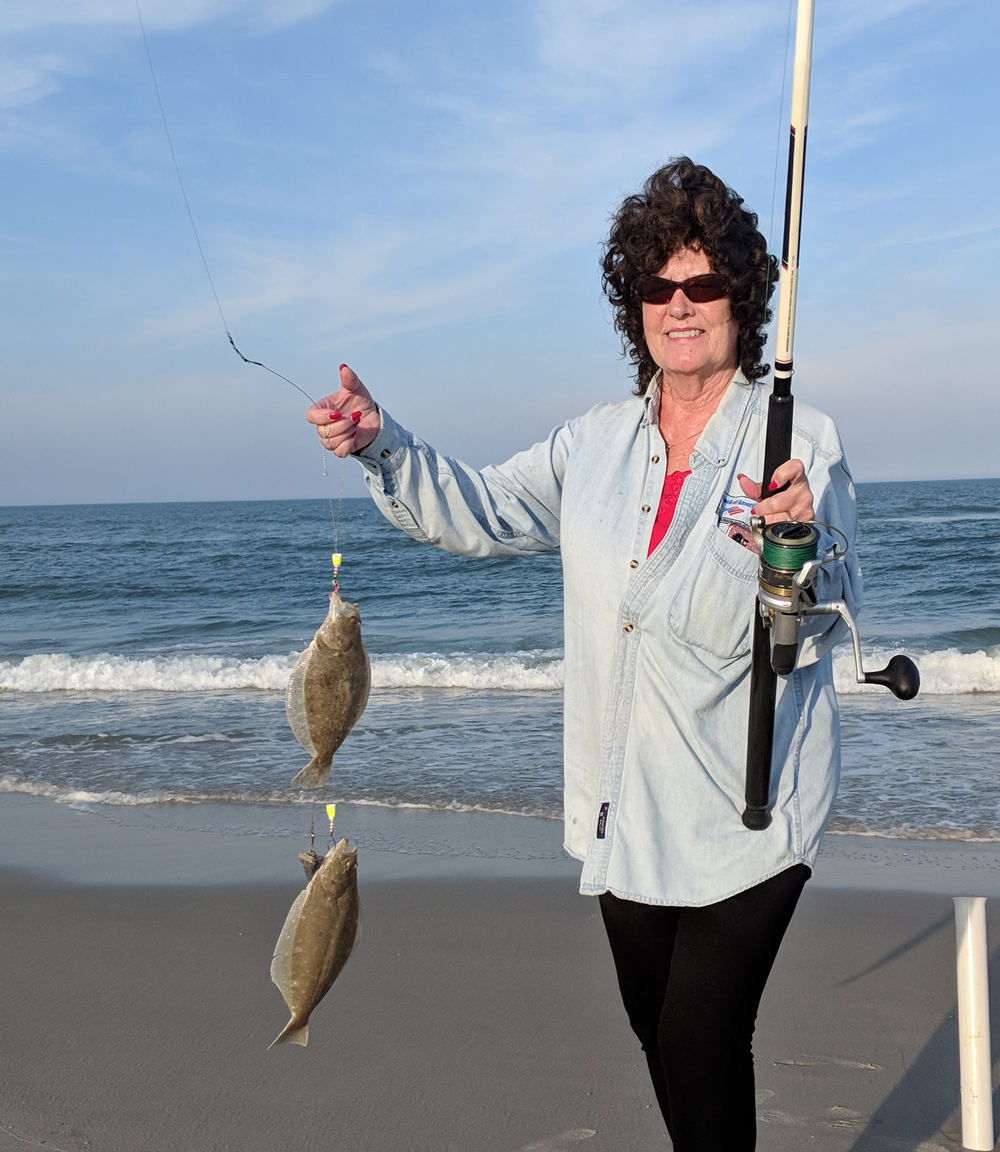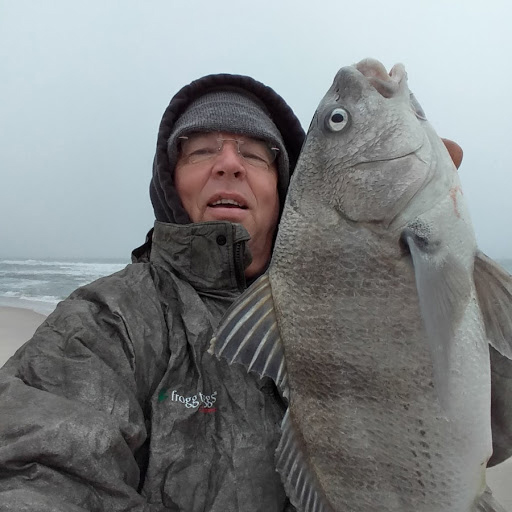Maybe you already have some surf fishing tips up your sleeve, and you checked out our article How to Go Surf Fishing for Sharks but want to go after a broader range of species. Either way, on the Delmarva Peninsula April begins surf fishing season with the arrival of big stripers, chopper blues, and black drum. As the pages of the calendar turn, the catch expands to include sea trout, croaker, spot, blowfish, flounder, snapper bluefish, kingfish (whiting), sharks, skates, and stingrays. Even an occasional pompano finds its way this far north some years. Fishing peaks in the fall, with October providing some of the best surf action of the year. Ready to get in on a red-hot bite in the cool fall suds? Here’s how to make it happen.

Bait in The Breakers
Stripers and drum are partial to clams, peelers, and sand fleas, especially early in the season. They also find fresh bunker (menhaden) tasty. Other offerings such as bloodworms, mullet, and squid round out the menu.
Squid is the universal surf fishing bait. Clean squid by pulling the head off, then cutting the body open from end to end. Remove the innards and scrape the outer skin off. Cut the cleaned body into pennants about two to three inches long. The tentacles can be cut off the squid head as well. A single tentacle with a piece of Fishbites makes a good kingfish bait, and the squid/Fishbite combo will catch most species in the surf.
If a spot is caught, savvy surf anglers will use it as a primary bait – I’m not sure if there’s a better bait than a fresh spot fileted and cut into strips. Small spot can even be fished live, when large predators are around.
Speaking of live bait: there’s plenty of it available right there on the beach, for anglers inclined to put in some effort. Sand fleas are probably eaten by every species swimming in the surf, and are fairly easy to catch. As a wave’s wash rushes back off the beach, look for colonies of sand fleas that are digging in the sand. Each flea leaves a “V” shape in the water as it digs under. The colony thus disrupts the receding water, giving their location away. Dig a few inches into the surface in these areas to obtain all the fleas you want. Incoming tide is best, as the colonies move up the beach with the tide. Early in the season colonies have not yet formed, but fleas can still be found by digging down six to eight inches at the water’s edge. Fleas that have molted and have a soft shell, along with fleas full of eggs, are the best for bait.
Throwing a cast net can provide live bait as well. Just remember to time throws so the net falls behind the wave coming onshore, in the calmest spot. Depending on time of year, mullet, spot, and crabs are available. Small baitfish also wash in with the breaking waves and can be caught in the whitewater.
Live minnows may get strange looks from some surf anglers, but flounder devour them in the surf just like in the bay. If you’re targeting flounder in specific, however, remember that most will be caught close to shore right behind the first breakers. Casting a bucktail sweetened with Gulp! Shrimp, Swimming Mullet or a bucktail/minnow combination will get their attention as well.

Finally, bloodworms are hard to beat for many of the smaller bottom feeders found in the surf like spot, croaker, and kingfish. Just remember that crabs tear them up sometimes, and this gets expensive, fast. Fishbites bloodworm flavor are a good, less expensive alternative.
Fishing Gear for the Beach
You don’t have any surf rods? That’s no problem. Often fish can be caught almost right on the beach. If you have a fishing rod and enough proficiency to cast 50 feet, you are in business. If you’re just beginning to dabble in surf fishing and looking to buy some new gear, stay away from those huge surf rods a dozen or more feet long. It takes experience to cast those rigs, not to mention the tiring effect of holding a pole that large. They are great for throwing six ounces of weight and large chunk of bait in springtime, but unless you’re targeting large species, they are often overkill. An eight- or nine-foot outfit spooled with 20-pound test braid line will handle 90-percent of the fish found in the surf and is much easier on the arms.
Unlike many types of fishing, the additional equipment needed to get started is minimal. A couple bottom rigs, a bait knife, cutting board, rag, and a five-gallon bucket to carry everything in (which can also serve as your seat) gets you started. It is quite beneficial to have a sand spike (a three-foot piece of two-inch PVC cut on an angle at one end). It will let you drop your rod in and keep the reel out of the sand when baiting hooks, or when you grow tired of holding the rod. But keep in mind, holding a rod allows you to feel the bite and react accordingly – with the rod in a sand spike, you often won’t even know there’s been a strike.
As for rigging, a standard double-hook bottom rig with short shank number-four hooks and a two- to three-ounce pyramid sinker gets the job done. Most of the fish caught in the surf are on the small side, so don’t use larger hooks unless you’re targeting bigger fish like stripers, blues, or drum in specific. My rule of thumb: big fish can be caught on a small hook, but small fish cannot be caught on a big one. Keeping hook leader lengths to five or six inches or less prevents most tangles. The best sinker weight to choose will vary depending of surf conditions, but as a general rule use the least amount of weight needed to consistently hold bottom. When fishing for larger species, use a three-way swivel with 30 inches of leader and hook to match the bait size.
Floats can be attached to rigs so the bait floats above the crabs, when they are a problem. All of the tackle shops catering to surf fishermen have “doodlebug” rigs, which have floats of varying colors already rigged in front of the hooks.
How to Read the Surf
Reading the water is an art, learned only by watching and studying the surf. Fish may be caught anywhere at any time along a beach, but the angler who learns to read the water has a great advantage when casting out a line. Storms and rough conditions constantly change the bottom contours along a beach, creating holes, troughs, and channels, which are prime feeding areas. Cuts or channels through the outer sand bars off the beach offer one of the best opportunities for bent rods. They create a funnel that brings in an array of fish. To locate one, watch waves building and breaking as they come onto the outer bar. When you can identify an area where waves do not break, but consistently build and roll over a section of the bar without white water, you’re in luck – the water here is deeper than the rest of the bar. Low tide is the best time to observe for these beach fishing hotspots.

On bright, sunny, calm days, you can also look for darker-colored water between the beach and outer bar, which indicates more depth. The increase in depth is not only identifiable by color but by observing how the waves form and break. When white water traverses over deeper water, it disappears and a wave begins to form again, indicating a hole or trough area where a line should be cast.
Remember: it is not necessary to always make long cast. A trough often forms within a few yards of shore, and many anglers actually over-cast fish in the surf. Although a trough may be almost right on the beach do not discount it from holding feeding fish, especially during high tide. Small baitfish call this area home, and at times attract predators right behind the whitewash. Typically, the last couple hours of incoming or first two hours of the falling tide provides the best fishing. Combine high tide with sunrise or sunset, and you have prime conditions.
Surf fishing is a great family sport. Provide the kids with light outfits that are easy to handle, and rigs with number-six or number-eight hooks baited with very small strips of squid or pieces of bloodworms. This will normally keep them busy catching small spot and kingfish at the surf’s edge, which you can then use as cut bait – or fish live on a fish-finder rig, for that trophy stripers in the suds!
Surf Fishing Tips
- Cast out and slowly wind your rig back in, to locate fish.
- Light east winds bring fish close to shore.
- The best fishing is normally at dawn, dusk, or overcast days.
- Use floats on hooks (Doodlebug rigs) to keep your bait off bottom, when crabs are tearing up your baits.
- Do not try to force large fish up onto the beach as a wave washes back down it; use incoming wave action to help land the fish.
- Squid combined with a one-inch piece of Fishbites Bloodworm flavor is a top bait choice.
-By John Unkart